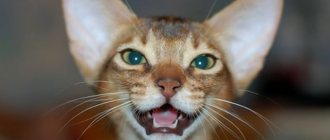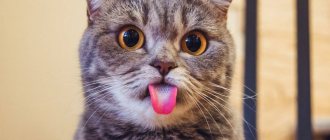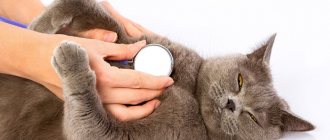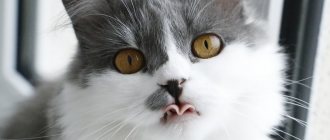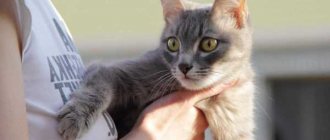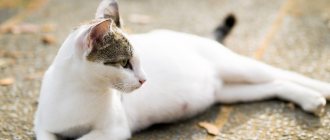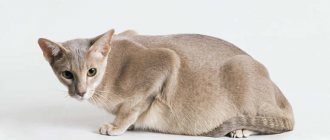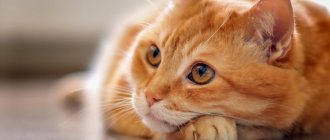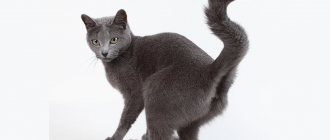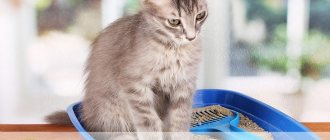The occurrence of breathing in a cat with an open mouth, accompanied by rapid inhalations and exhalations, is called shortness of breath. Shortness of breath is associated with a sharp lack of oxygen entering the body, causing brain hypoxia.
In veterinary medicine, as in human medicine, there are two types of dyspnea - provoked by physiological factors and pathological changes. Physiological shortness of breath is a reversible condition and, as a rule, does not require medical intervention. If shortness of breath occurs against the background of a serious illness, then it requires treatment to eliminate the underlying factor.
It is important to remember that shortness of breath that appears in a cat cannot be ignored and it is important to take this manifestation seriously. Rapid inhalation and exhalation indicates disturbances in the functioning of the body, sometimes threatening the health and even the life of the animal.
When fast breathing is normal
Rapid breathing in cats (tachypnea, inspiratory dyspnea) is characterized by an increased number of inhalations and exhalations relative to the norm. It occurs in animals for a variety of reasons.
Important! Tachypnea can be physiological or pathological. Physiological rapid breathing is a natural process of cooling the body and is necessary for faster recovery.
When this condition develops, the pet most often stretches out its front legs and arches its back. However, tachypnea does not always signal the development of any pathological condition or process in the body.
Rapid breathing may be normal:
- in the first hours after the birth of kittens;
- with a long stay in a stuffy room, in the heat (overheating);
- if the cat is very thirsty;
- after intense physical activity, active games;
- during or immediately after eating;
- in stressful situations, after a strong emotional shock (transportation, change in familiar environment).
Rapid breathing in a cat can be caused by taking certain medications. In particular, when recovering from deep anesthesia.
A cat may pant frequently during pregnancy due to hormonal changes in the body during the rut.
As a rule, all of the above factors do not represent. The respiratory function will return to normal after some time, for example, after the normalization of the emotional state, the end of games, etc.
We also note that in representatives of brachycephalic breeds, due to the specific anatomical structure of the nasal passages (flattened nose), rapid breathing, especially in the hot season, is a physiological norm.
Causes of abnormal rapid breathing in cats
Owners should sound the alarm if their cat's rapid breathing is pathological.
Causes of abnormal increased breathing in cats:
- pathologies of the respiratory tract;
- acute and chronic respiratory infections (tracheal collapse, bronchitis, rhinotracheitis, edema, neoplasia);
- the presence of foreign bodies in the pharynx, larynx;
- pathological, inflammatory processes in the bronchi (asthma, helminthic infestations);
- pathologies of the nose (blockage of the nasal passages with mucus, foreign objects, spasm of the respiratory tract);
- severe intoxication;
- dehydration;
- abnormal structure of the skull;
- hydrothorax, hemothorax (accumulation of fluid, blood in the sternum);
- oxygen starvation (hypoxia);
- hernias in the diaphragm;
- poisoning with strong chemicals and poisons;
- sternum injuries;
- lung damage;
- brain tumors;
- inflammatory process in the oral cavity, problems of the soft palate;
- neoplasms in the respiratory tract;
- endocrine diseases and pathologies, metabolic problems;
- high temperature, fever;
- pneumothorax (accumulation of air in the sternum);
- severe overheating;
- cardiovascular pathologies (heart failure, myocardial enlargement, cardiomyopathy);
- shock, fear, acute pain.
Important! The main cause of tachypnea is impaired gas exchange. This condition is provoked by an increase in carbon dioxide in the bloodstream and a decrease in oxygen levels, which leads to excitation of the respiratory center. Such a violation leads to a decrease in the level of irritation of the neuro-reflex apparatus in the alveoli of the lungs.
Rapid breathing in cats is observed during acute allergic reactions (anaphylactic shock), and with diseases of various types of internal organs. This condition may be a symptom of neurological diseases,
Basic information
Rapid breathing is caused by the following reasons:
- Surgery, including sterilization. In this way (by increasing heart rate and breathing), the cat’s body tries to recover after the administration of medications. The frequency and depth of breaths may be disrupted, and then level off on their own. If the lips, gums and nose begin to turn blue, the cardiovascular or respiratory system is affected. The cat needs qualified veterinary care;
- Overheating of the animal, including after physical activity. Unlike humans, cats do not have sweat glands. Therefore, tachypnea occurs when the animal tries to cool down. At the same time, the cat sticks out its tongue and breathes briefly and frequently.
- Okot. Childbirth is a strong stress for the body, which can cause rapid breathing. After giving birth, your cat may not need help if her breathing returns to normal over time.
- Severe fright or stress can cause emotional distress in a cat. In addition to external signs (severe fear and pinned ears), hidden ones (pain) are also added. In addition, the animal can show aggression - attack or hide.
- Pathologies of internal organs, leading to an increase in the size of these organs, increased abdominal pressure, ascites, diseases of the heart, blood, lungs and endocrine disorders.
Additional symptoms and complications
Rapid breathing caused by physiological reasons does not cause discomfort to the cat.
Additional symptoms and complications:
- severe frequent attacks of suffocating cough;
- a sharp increase in temperature;
- inadequate response to stimuli;
- anemia, pallor, cyanosis, excessive redness of the mucous membranes;
- nose bleed;
- heart rhythm disturbances (arrhythmia, tachycardia, bradycardia);
- change in habitual behavior (anxiety, nervousness, depression, apathy);
- strong thirst;
- wheezing;
- unnatural poses;
- discharge from the nose, eyes, mucous, purulent;
- fast fatiguability;
- trembling, muscle spasms, cramps;
- frequent urination;
- refusal to eat;
- vomiting, profuse diarrhea;
- weight loss.
If, in addition to tachypnea, the cat loses consciousness, is not oriented in space, is choking, is breathing heavily intermittently, wheezing, whistling sounds are heard, the heart rate has changed, do not waste a minute. Contact your veterinarian immediately or take your cat to a veterinary clinic.
Cardiopalmus
Rapid heartbeat is one of the symptoms most often noted with tachypnea.
The heartbeat changes after taking certain medications. For example, after vaccination. This is how the body responded to the vaccine. In this case, respiratory function should recover within 12-24 hours.
If your cat's mucous membranes turn blue, the heart rate increases (arrhythmic pulse), the pet loses consciousness, breathes heavily, behaves inappropriately, do not waste a minute. Call a veterinarian at home or take it in a shipping box to the nearest veterinary hospital.
Heat
High temperature and rapid breathing can be caused by both external and internal factors. Overheating, dehydration, stress, childbirth, hormonal changes, intestinal disorders, acute poisoning, respiratory, viral and bacterial diseases, acute inflammation.
An increase in temperature can be observed in a cat after vaccination, deworming, or at the beginning of the development of inflammatory processes in the body.
Lethargy and apathy
As we have already noted, if a cat has rapid, pathological breathing, in some conditions the cat may experience either severe agitation or possible lethargy and apathy.
Important! Lethargy and apathy can be caused by exhaustion, shock, or neoplasia.
The alarm should be sounded in the case of a lethargic state, severe depression, cyanosis of the mucous membranes, lack of response to external stimuli, and unstable temperature.
Convulsions
Convulsions, rapid breathing, muscle spasms, tremors in a cat can occur against the background of neurotic conditions, severe intoxication, poisoning with potent poisons, chemicals, medications, or ingestion of exogenous toxins.
The development of this condition is facilitated by impaired gas exchange, oxygen starvation, shock, and strong emotional overexcitation.
Alcohol poisoning
Some substances containing ethyl alcohol and ethanol, when ingested, have a damaging effect on the human central nervous system. As a result of reactions in the body, ethanol is converted into a combination of acetaldehyde and acetic acid. It is these compounds that affect the internal organs and tissues of the body causing poisoning.
Signs of alcohol poisoning
- impaired coordination of movement (uncertain gait, staggering);
- emotional instability;
- redness of the skin (red face);
- gagging and nausea;
- in severe poisoning, loss of motor activity, impaired consciousness and depression of respiratory function
Ignorance of limits, abuse of alcoholic beverages, and simply poisoning sometimes leads to serious consequences. They are characterized by:
- comatose state with complete loss of consciousness
- decreased pain reflexes
- impairment of human visual functions
Symptoms of this condition are:
- constricted pupils or pupils of different sizes, most often this depends on impaired respiratory function
- slow muscle reactions and reflexes
Experts divide the state of alcoholic coma into two stages. The first stage is characterized by weak reactions to pressure on pain points, injections, and strong odors (ammonia vapor). It is expressed in weak retaliatory attempts to defend oneself with one’s hands and brush them off.
The second stage of alcohol poisoning is characterized by an almost complete lack of reaction to pain, while the pupils practically do not react to light at all.
The development of deep coma during poisoning is characterized by a decrease in all physical activity, reflexes and movement, and a decrease in body temperature. The most dangerous thing is the lack of medical care for respiratory dysfunction in this condition. This is the main cause of death from ethanol poisoning.
The most common phenomena in deep alcoholic coma are:
- profuse salivation
- tongue retraction
- hoarse weak breathing
- nausea (especially dangerous if vomit enters the respiratory tract)
- bluish complexion
- decrease in blood pressure
- rapid heartbeat and poor circulation
First aid
The very first action in case of alcohol poisoning is to call an ambulance. If the victim reacts to external influences, he is clearly inhibited in his actions and drowsiness, it is necessary to put a cloth soaked in ammonia under his nose and, if possible, rinse his stomach.
To rinse your stomach, you need to drink a lot of water with the addition of baking soda, at least a liter. Next, you should put two fingers in your mouth to trigger a gag reflex.
During alcohol consumption, the superficial blood vessels of the skin cool, so after gastric lavage, you need to warm the victim.
If you have activated carbon or other adsorbent agent, it would be a good idea to give it to the victim. Take activated carbon at the rate of 1 tablet per 10 kg of weight.
If the victim does not respond to external stimuli and is in a comatose state, it is necessary to turn him on his stomach to avoid vomit from entering the respiratory tract.
First aid for a cat
A cat requires first aid when breathing has not returned to normal and the pet’s condition is rapidly deteriorating.
First aid for a cat:
- If the cat is choking, coughing, stretching its neck forward, breathing with its mouth open, try to calm the pet down, and then inspect the upper respiratory tract for the presence of foreign objects.
- Clear your pet's nostrils and mouth of mucus.
- Roll your palm into a tube and inhale air into the cat’s mouth or nose. Carry out this manipulation every 2-3 seconds.
- Perform artificial ventilation.
- Create a favorable microclimate in the room. Ventilate the room well.
- If your cat is overheated, take your pet to a cool, dark place. Wet your head and nose with a damp towel. Offer the animal to drink or after a while pour water into the mouth from a syringe without a needle in small portions.
- If your tongue turns blue or your temperature drops, place a heating pad on your paws.
Constantly monitor your pulse and heart rate. If the pulse is weak, perform chest compressions. Monitor your pet's condition until the veterinarian arrives.
Diagnostic methods
If an adult cat or kitten is breathing rapidly and its condition is rapidly deteriorating, it is necessary to urgently take the pet to the hospital. At the appointment, the doctor will examine the animal, ask the owner how long ago his pet began to have difficulty breathing air, and collect other important data. The condition of the respiratory system is checked using an x-ray; the doctor uses special instruments to examine the throat and nose. If your cat is mouth breathing and has fluid accumulated in its lungs, the doctor will use a puncture needle to take a sample for laboratory testing. Additionally, the following diagnostic methods are prescribed:
For a more detailed examination of the animal and to identify the cause of the symptoms, the doctor may send him for an ECG.
- general clinical analysis of blood and urine;
- biochemistry;
- coprogram;
- Ultrasound of internal organs;
- ECG.
Return to contents
